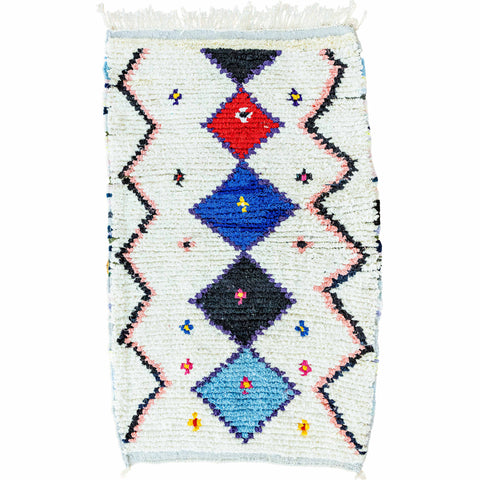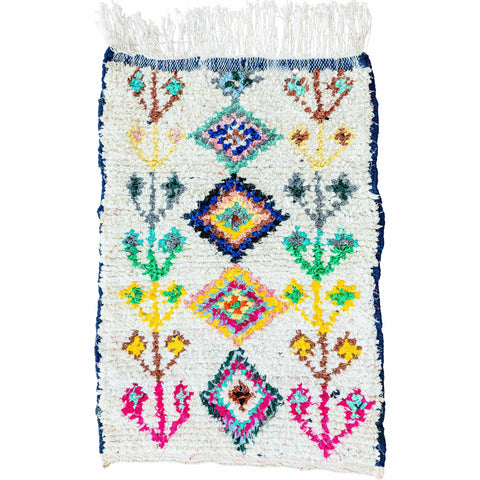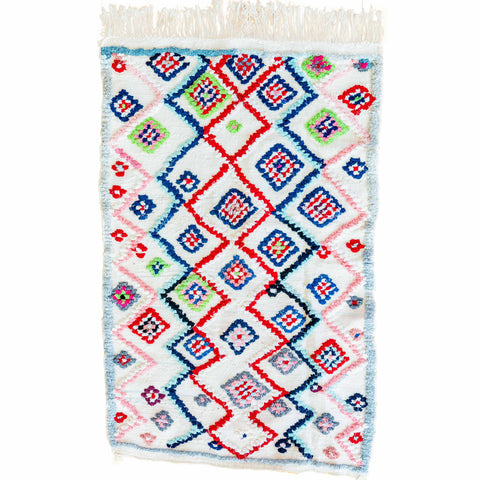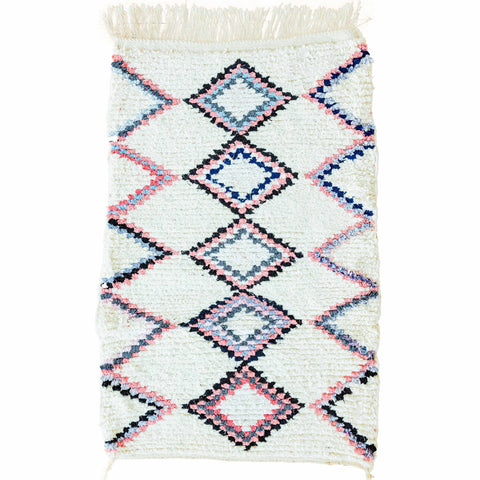13 Ways to Tell Authentic Moroccan Rugs From Fakes

Crafted by Berber artisans. Curated by decor enthusiasts
Wouldn’t it be nice if you could identify authentic Moroccan rugs and spot fakes faster? Is it possible in a world where everything is machine-made?
How do you know if you are investing in genuine rug art from Morocco? Is there a way to identify counterfeit mass-produced textiles using cheap materials?
The answer is easy and lies straight ahead. The best part is you can learn it in the next few minutes.
What are Authentic Moroccan Rugs?
Genuine Berber carpets from Morocco are handmade one at a time. They are never made in a factory by machines. (Learn more about what makes these Morocco rugs vintage.)
Here are 13 ways you can tell authentic Moroccan rugs from their fake counterparts.
1. Is it made of wool?
Legitimate Moroccan handmade rugs are made from 100% sheep wool with some cotton threads. Less often, you will find rugs made of silk, cotton, goat hair, leather, palm reeds, camel hair, and old clothing. It depends on the region of Morocco and the availability of materials to use.
2. Is it soft?
The "wool" is the softest part of animal hair while the "hair" is the coarser wool strands. The highest quality Morocco accent rugs made of true wool will feel very soft.
3. Does it have a sheen?
Only good quality wool has a sheen to it. This is only possible by shearing living animals. Poor quality wool comes from shearing animals that are no longer alive. There is a beautiful luster to “live wool” which makes it more expensive than “dead wool.” It is also less brittle and will last longer.
4. Is it made of cotton?
Cotton is less expensive than wool which is why it is becoming more popular to find Moroccan cotton rugs.
5. What tribe made the rug?
The city, area of Morocco, or the tribe that made the rug is usually mentioned. Every tribe or area has its own unique way of creating Moroccan tribal rugs.
6. Is it handmade?
Rugs made by hand and not machine-made is a great way to check authenticity. All tribes or regions have their own distinctive style of making handmade rugs. But, each is unique because they are handcrafted. If you see many Moroccan carpets that look exactly alike, then you know they are factory-made.
7. Is it urban?
Rugs made in urban areas of Morocco tend to be more refined. The designs use symmetrical patterns, one or more central medallions, and floral motifs. They are also less shaggy with a higher knot count. Workshops and small craft groups is where you can find urban Moroccan rugs.
8. Is it rural?
Berber women make rural Moroccan rugs. The designs are much simpler featuring straight lines, abstract patterns, and talismanic symbols. The carpet weft (yarns that run on the loom horizontally) is not tight and irregular. They are asymmetrical in nature and woven using wool. But sometimes cotton, goat hair, or camel hair. You can find both flat-weave rugs and carpets with a thicker pile in rural areas.
9. Is it a rag rug?
Boucherouite carpets are rag rugs made from strips of old clothing. Using recycled materials is the main focus of artists. Wool may be difficult to find or too expensive to use. Instead, they create using what they already have. These Moroccan Boucherouite rag rugs are increasing in popularity around the globe.
10. Is it knotted?
All rugs certified by the Moroccan government must be handmade, knotted, and use only wool. This regulation is important to preserve the authenticity and quality of the Morocco Berber carpets. This also ensures the preservation of cultural heritage.
11. Is it colorfast?
Test for colorfastness of the rug dye by getting a white paper napkin wet and pressing it against the rug. If no dye appears on the napkin, then the dyes are colorfast. Synthetic dyes will bleed which devalues colorful carpets.
12. Is it an antique?
It is very unusual to find a Berber Moroccan rug more than a hundred years old. These antique rugs are in extremely rare supply.
13. Is it vintage?
Rugs made 20 years ago are vintage. They are worth more in value due to their age and lower supply.
What Colors are in Authentic Moroccan Rugs?
Real handmade rugs from Morocco use a wide range of colors. Azilal rugs primarily use white and natural wool colors as the foundation with black or colorful designs as accents. Beni Mguild rugs use the deep bold colors of magenta, blue, and dark orange in diamond patterns.
In general, Moroccans are not afraid to use generous doses of saturated colors. Colorful floor coverings in a sandy landscape bring cheerfulness and beauty. There is a true love of color found in every masterful textile created.
The most in-demand colors for decorating with floorcloths in Moroccan style include blues, greens, reds, yellows, oranges, blacks, and neutrals. If you see a pink Moroccan rug, grab it up! This is a less commonly used color in comparison to red. Rug collectors love seeking out carpets in shades of pink and rose to add to their collection.
Buy Only Genuine Morocco Rugs
Genuine Morocco rugs are of high quality and one-of-a-kind. You will never see two that are exactly alike. It takes several weeks to months to craft each masterpiece.
This is why they are higher in value which increases over time. The problem is too many people try to capitalize on it by passing off fakes as real. Get wise and use the tips above to look a little closer before you buy.
By the way, did you know Coco Carpets carries a wide selection of authentic Moroccan rugs? It is true. We find each Coco rug by meeting with the tribal people who make them by hand. Each handpicked piece ensures they are genuine.
Save time, money, and a big headache by giving us a try first! I promise you won’t regret it.
So, over to you. What are your best tips for checking authenticity?

































